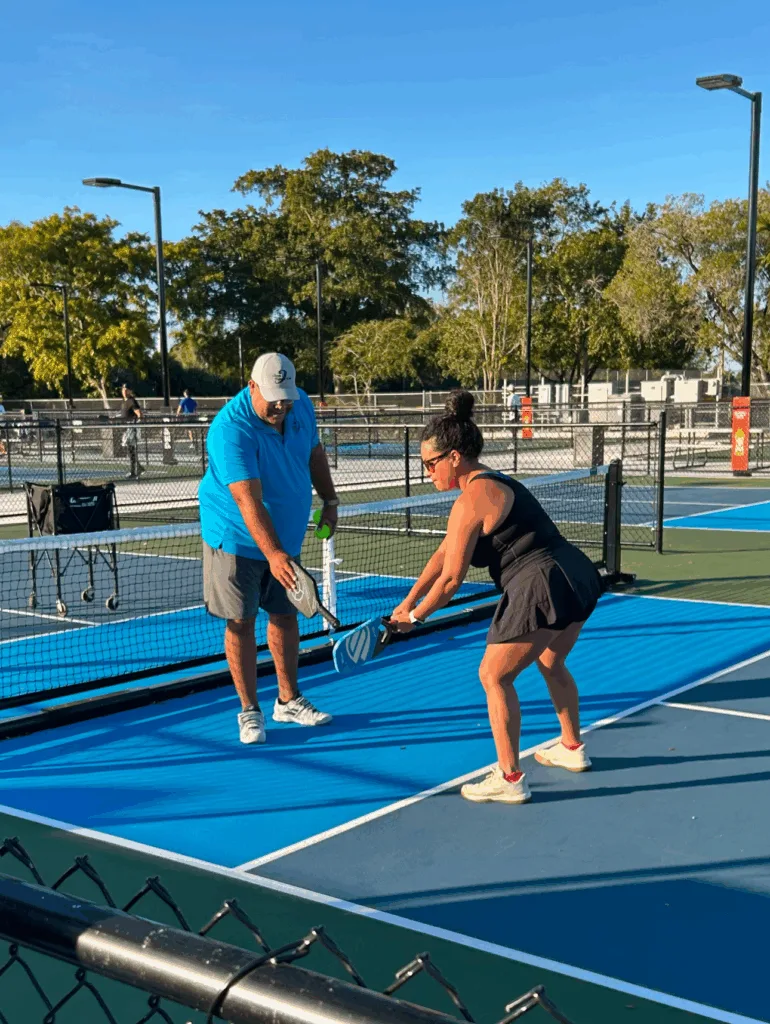With pickleball’s explosive growth, the equipment market has expanded dramatically. Walk into any sporting goods store, and you’ll find dozens of paddle options, countless balls, and gear you never knew existed. While having choices is great, it can also be overwhelming. This comprehensive guide will help you navigate the equipment landscape and make informed decisions that truly improve your game—without breaking the bank.
Pickleball Paddles: Your Most Important Investment
The paddle is your primary tool, and choosing the right one can significantly impact your performance. Here’s what you need to know about the key factors that matter.
Weight Classes and Their Impact
Lightweight Paddles (6.0-7.3 oz)
- Best for: Players with arm issues, seniors, or those who prefer quick hands at the net
- Advantages: Easy maneuverability, less fatigue, excellent for dinking and quick reactions
- Trade-offs: Less power on drives, can feel unstable on hard shots
Midweight Paddles (7.3-8.2 oz)
- Best for: Most recreational players and those seeking versatility
- Advantages: Good balance of power and control, suitable for all playing styles
- Trade-offs: Jack-of-all-trades but master of none
Heavyweight Paddles (8.2-9.5 oz)
- Best for: Aggressive players who like to drive the ball and play power pickleball
- Advantages: Maximum power, stable feel, great for put-away shots
- Trade-offs: Can cause fatigue, slower reaction times at the net
Paddle Shape and Sweet Spot
Standard Shape The traditional paddle shape offers a good balance of power and control with a centered sweet spot. This is ideal for most players.
Elongated Shape These paddles are longer and narrower, providing more reach and a different sweet spot location. Popular among former tennis players.
Widebody Shape Wider paddles offer a larger sweet spot, making them more forgiving for beginners or players who want maximum consistency.
Core Materials: The Hidden Performance Factor
Polymer Honeycomb Core
- Most popular choice offering good touch and control
- Quieter than aluminum cores
- Excellent for players who prioritize finesse over power
Aluminum Honeycomb Core
- Provides more power and a “poppy” feel
- Louder than polymer
- Great for aggressive players who want maximum ball speed
Nomex Honeycomb Core
- Hardest core material offering maximum power
- Very durable but can be harsh on the arm
- Best for competitive players seeking every advantage
Face Materials: Power vs. Control
Fiberglass
- Offers excellent power and a firm hitting surface
- Provides good ball speed but less touch
- Popular among aggressive players
Carbon Fiber/Graphite
- Premium material offering the best touch and control
- Allows for precise shot placement
- Preferred by finesse players and professionals
Composite
- Blend of materials offering balanced performance
- Good option for players who want versatility
- Often more affordable than pure carbon fiber
Budget-Conscious Paddle Selection
Under $50: Getting Started Right Look for paddles from established brands with polymer cores and composite faces. Avoid paddles that seem too cheap—they often lack durability and performance.
$50-$100: The Sweet Spot This price range offers excellent value with quality materials and construction. Most recreational players will find everything they need here.
$100-$200: Premium Performance High-end materials like carbon fiber faces and advanced core technologies. Worth it for serious players who play multiple times per week.
$200+: Tournament Level Professional-grade equipment with cutting-edge materials and construction. Only necessary for competitive tournament players.
Pickleball Balls: Indoor vs. Outdoor
Understanding ball differences is crucial for optimal play and equipment longevity.
Outdoor Balls
- Smaller, more numerous holes (typically 40 holes)
- Heavier and more durable
- Designed to handle wind and rough court surfaces
- Popular brands: Dura, Penn, Onix
Indoor Balls
- Larger, fewer holes (typically 26 holes)
- Lighter weight for controlled indoor play
- Softer plastic that’s easier on paddles
- Popular brands: Jugs, Gamma, Onix
Tournament Balls If you’re playing in sanctioned tournaments, make sure to practice with the same ball brand that will be used in competition. Ball characteristics can vary significantly between brands.
Court Shoes: Foundation for Performance
Why Tennis Shoes Work Best Tennis shoes are designed for lateral movement, quick stops, and court surfaces—exactly what pickleball demands. Look for:
- Non-marking soles (required on most courts)
- Good lateral support
- Durable construction for court surfaces
- Comfortable fit for extended play
Avoid Running Shoes Running shoes are designed for forward motion and lack the lateral support needed for pickleball’s side-to-side movement patterns.
Indoor vs. Outdoor Courts
- Indoor courts: Shoes with gum rubber soles for better grip
- Outdoor courts: More durable construction to handle asphalt or concrete
Apparel: Comfort and Performance
Moisture-Wicking Fabrics Synthetic materials that pull sweat away from your body keep you comfortable during long playing sessions.
UV Protection For outdoor play, consider clothing with UPF ratings to protect against sun exposure during extended play.
Freedom of Movement Choose apparel that doesn’t restrict your range of motion. Pickleball requires reaching, lunging, and quick directional changes.
Accessories That Actually Matter
Paddle Covers and Cases Protect your investment with a quality paddle cover, especially if you transport your paddle frequently.
Overgrips Customize your grip size and feel with overgrips. They’re inexpensive and can significantly improve comfort and control.
Wristbands and Headbands Simple accessories that can improve comfort and focus by managing perspiration.
Ball Retrievers For players who practice frequently, a ball retriever can save your back and speed up practice sessions.
Equipment Care and Maintenance
Paddle Maintenance
- Clean your paddle face regularly with a damp cloth
- Avoid extreme temperatures that can damage the core
- Replace grips when they become slippery or worn
- Inspect for cracks or damage before each play session
Proper Storage
- Store paddles in a cool, dry place
- Use paddle covers for protection
- Avoid leaving equipment in hot cars
When to Replace Equipment
- Paddles: When you notice cracks, dead spots, or significant wear
- Shoes: When tread wear affects grip or support declines
- Balls: When cracks appear or bounce becomes inconsistent
Testing Equipment Before You Buy
Demo Programs Many specialty pickleball retailers offer demo programs where you can try paddles before purchasing. Take advantage of these opportunities.
Borrowing from Friends Try different paddles from playing partners to understand what feels right for your game.
What to Test
- Comfort and feel during different shots
- Weight distribution and balance
- Sweet spot location and size
- Overall control and power
Red Flags: Equipment to Avoid
Overly Cheap Options Paddles under $30 are often poorly constructed and won’t provide a good playing experience or durability.
Unknown Brands Stick with established pickleball equipment manufacturers who understand the sport’s specific requirements.
One-Size-Fits-All Claims Be wary of equipment marketed as perfect for everyone. Good equipment is designed for specific playing styles and skill levels.
Building Your Equipment Arsenal
The Beginner Setup ($75-$150)
- Quality entry-level paddle ($40-$70)
- Court shoes ($50-$80)
- Basic athletic wear
The Recreational Player ($200-$400)
- Mid-range paddle ($80-$120)
- Quality court shoes ($80-$120)
- Paddle cover and overgrips ($20-$30)
- Performance apparel ($50-$100)
The Serious Player ($400-$800)
- High-end paddle ($150-$250)
- Premium court shoes ($100-$150)
- Multiple paddles for different conditions
- Complete gear bag setup
Conclusion
The right equipment can enhance your pickleball experience, but remember that gear doesn’t replace practice and strategy. Start with quality basics that match your current skill level and budget, then upgrade as your game develops and your preferences become clearer.
The most expensive equipment isn’t always the best choice for your specific needs. Focus on finding gear that feels comfortable, matches your playing style, and helps you enjoy the game more. As you improve, you’ll develop preferences that guide your future equipment decisions.
Ready to find the perfect equipment for your game? Visit JoliSports where our knowledgeable staff can help you test different options and find gear that truly enhances your pickleball experience. Book a consultation today and discover how the right equipment can take your game to the next level!

